engine TOYOTA tC 2016 (in English) Workshop Manual
[x] Cancel search | Manufacturer: TOYOTA, Model Year: 2016, Model line: tC, Model: TOYOTA tC 2016Pages: 492, PDF Size: 9.44 MB
Page 173 of 492
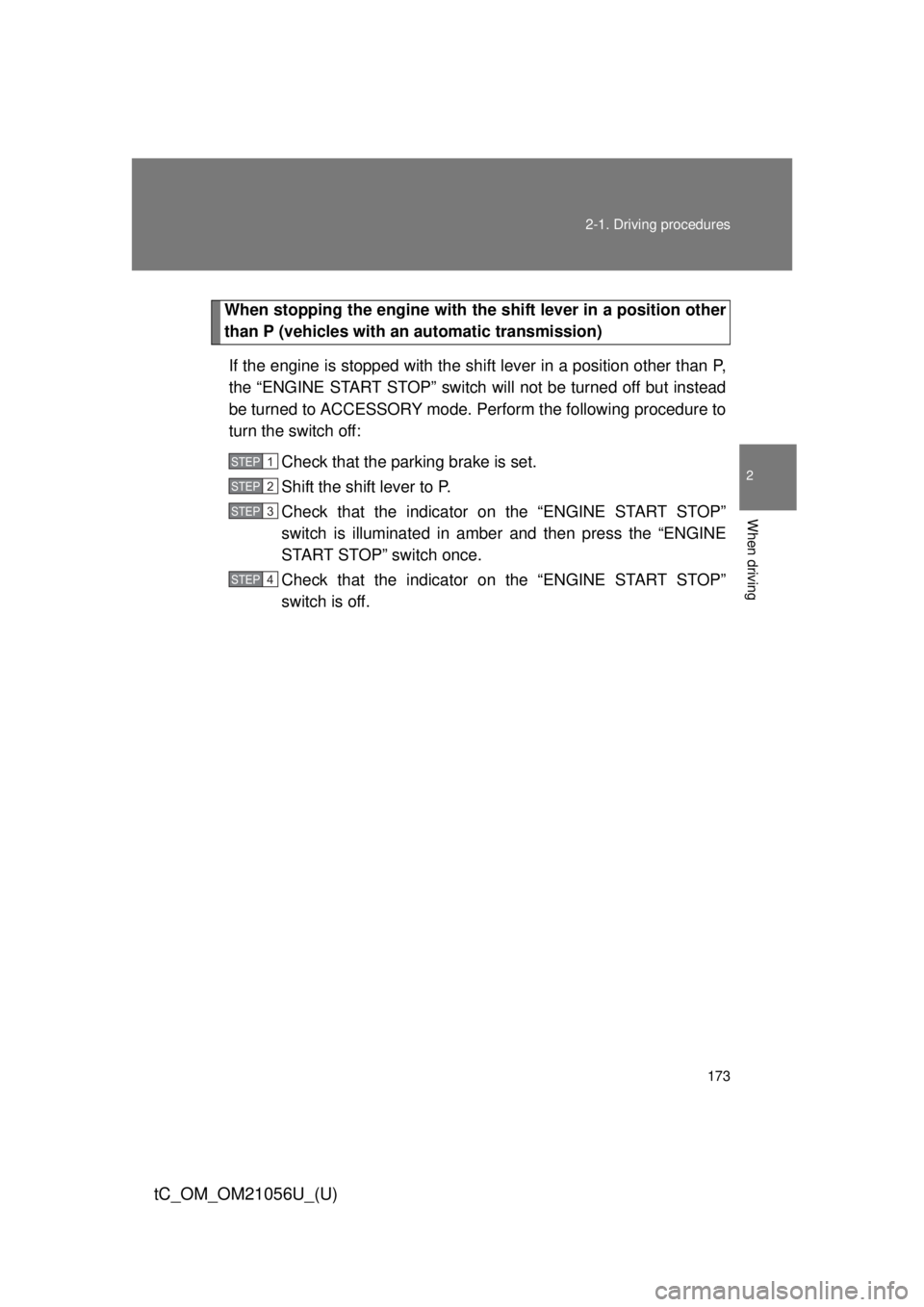
173
2-1. Driving procedures
2
When driving
tC_OM_OM21056U_(U)
When stopping the engine with the shift lever in a position other
than P (vehicles with an automatic transmission)
If the engine is stopped with the sh ift lever in a position other than P,
the “ENGINE START STOP” switch will not be turned off but instead
be turned to ACCESSORY mode. Perform the following procedure to
turn the switch off:
Check that the parking brake is set.
Shift the shift lever to P.
Check that the indicator on the “ENGINE START STOP”
switch is illuminated in amber and then press the “ENGINE
START STOP” switch once.
Check that the indicator on the “ENGINE START STOP”
switch is off.
STEP 1
STEP 2
STEP 3
STEP 4
Page 174 of 492

174 2-1. Driving procedures
tC_OM_OM21056U_(U)
■Auto power off function
Vehicles with an automatic transmission
If the vehicle is left in ACCESSORY mode for more than 20 minutes or IGNI-
TION ON mode (the engine is not running) for more than an hour with the
shift lever in P, the “ENGINE START STOP” switch will automatically turn off.
However, this function cannot entirely prevent battery discharge. Do not
leave the vehicle with the “ENGINE START STOP” switch in ACCESSORY
or IGNITION ON mode for long periods of time when the engine is not run-
ning.
Vehicles with a manual transmission
If the vehicle is left in ACCESSORY mode for more than 20 minutes or IGNI-
TION ON mode (the engine is not running) for more than an hour, the
“ENGINE START STOP” switch will automatically turn off. However, this
function cannot entirely prevent battery discharge. Do not leave the vehicle
with the “ENGINE START STOP” switch in ACCESSORY or IGNITION ON
mode for long periods of time when the engine is not running.
■ Operation of the “ENG INE START STOP” switch
When operating the “ENGINE START STOP” switch, one short, firm press is
enough. If the switch is pressed improperly, the engine may not start or the
“ENGINE START STOP” switch mode may not change. It is not necessary to
press and hold the switch.
■ Electronic key battery depletion
P. 4 5
■ Conditions affecting operation
P. 4 1
■ Note for the entry function
P. 4 2
Page 175 of 492
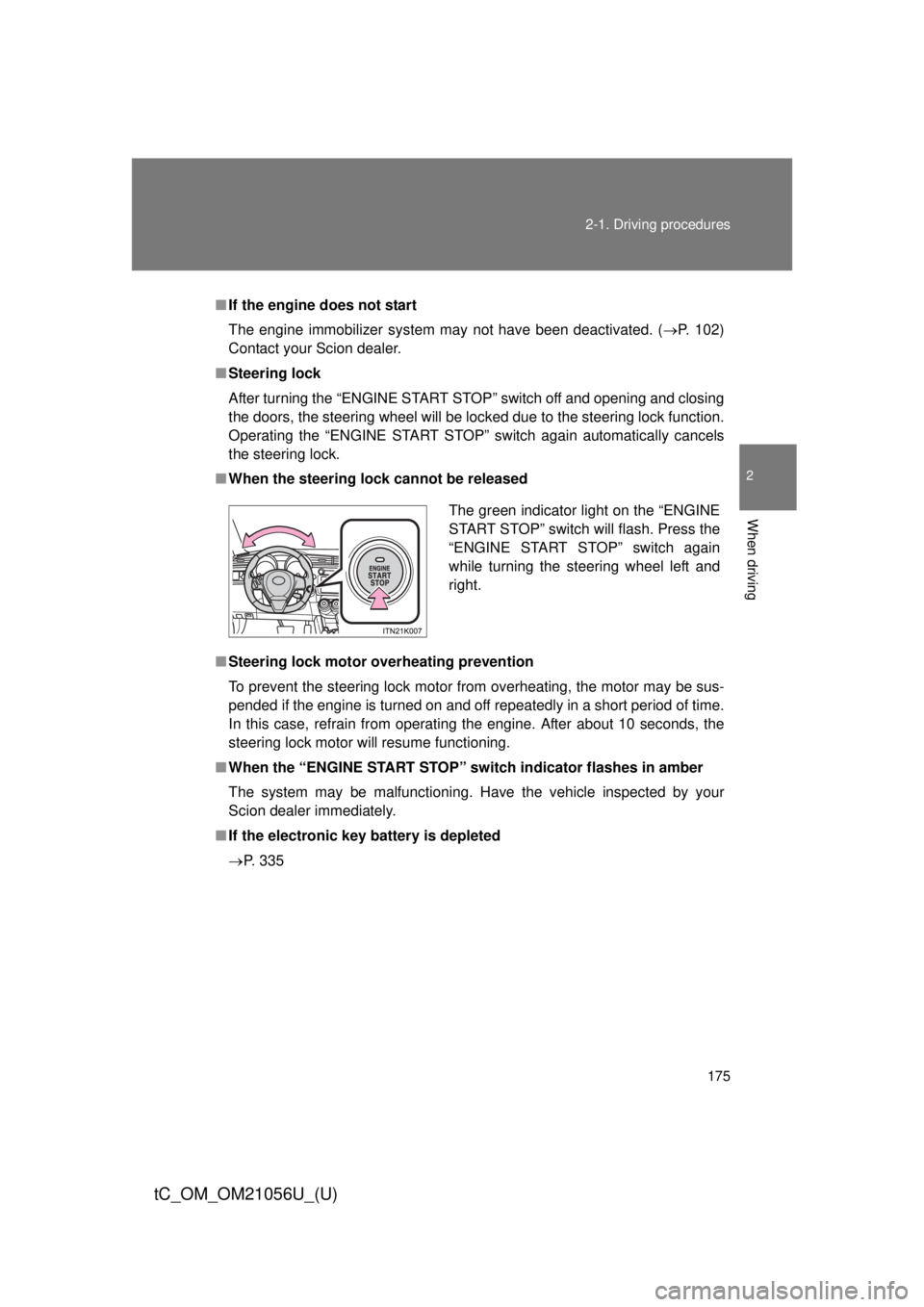
175
2-1. Driving procedures
2
When driving
tC_OM_OM21056U_(U)
■
If the engine does not start
The engine immobilizer system may not have been deactivated. ( P. 102)
Contact your Scion dealer.
■ Steering lock
After turning the “ENGINE START STOP” switch off and opening and closing
the doors, the steering wheel will be locked due to the steering lock function.
Operating the “ENGINE START STOP” switch again automatically cancels
the steering lock.
■ When the steering lock cannot be released
■ Steering lock motor overheating prevention
To prevent the steering lock motor from overheating, the motor may be sus-
pended if the engine is turned on and off repeatedly in a short period of time.
In this case, refrain from operating the engine. After about 10 seconds, the
steering lock motor will resume functioning.
■ When the “ENGINE START STOP” switch indicator flashes in amber
The system may be malfunctioning. Have the vehicle inspected by your
Scion dealer immediately.
■ If the electronic key battery is depleted
P. 335
The green indicator light on the “ENGINE
START STOP” switch will flash. Press the
“ENGINE START STOP” switch again
while turning the steering wheel left and
right.
Page 176 of 492

176 2-1. Driving procedures
tC_OM_OM21056U_(U)
CAUTION
■When starting the engine
Always start the engine while sitting in the driver’s seat. Do not depress the
accelerator pedal while starting the engine under any circumstances.
Doing so may cause an accident resulting in death or serious injury.
■ Caution while driving
If the vehicle begins to slide due to engine failure or other circumstances, do
not lock or open the doors until the vehicle reaches a safe and complete
stop. Activation of the steering lock in this circumstance may lead to an acci-
dent, resulting in death or serious injury.
■ Stopping the engine in an emergency
If you want to stop the engine in an emergency while driving the vehicle,
press and hold the “ENGINE START STOP” switch for more than 2 seconds,
or press it briefly 3 times or more in succession.
However, do not touch the “ENGINE START STOP” switch while driving
except in an emergency. Turning the engine off while driving will not cause
loss of steering or braking control, but the power assist to these systems will
be lost. This will make it more difficult to steer and brake, so you should pull
over and stop the vehicle as soon as it is safe to do so.
Page 177 of 492
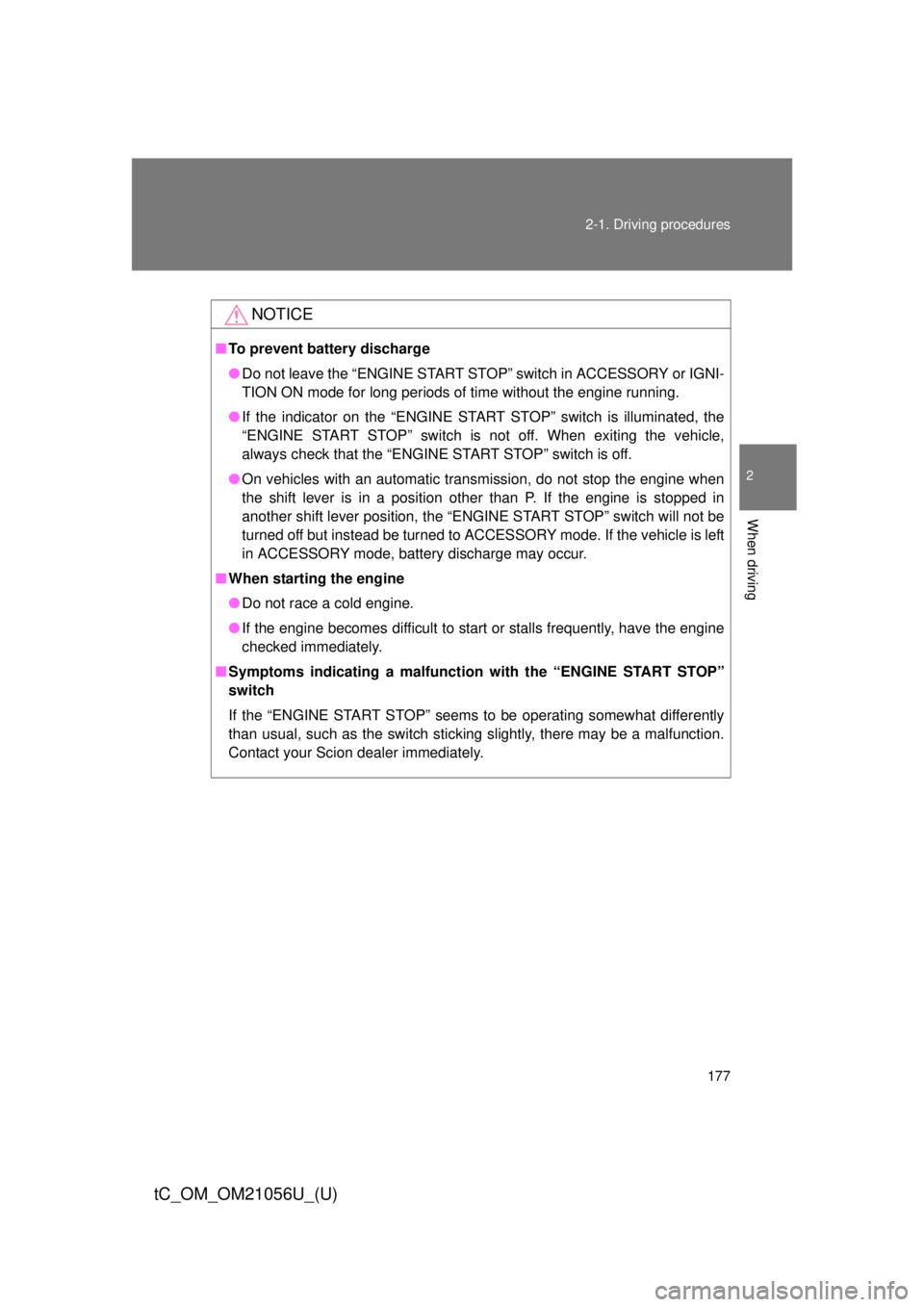
177
2-1. Driving procedures
2
When driving
tC_OM_OM21056U_(U)
NOTICE
■
To prevent battery discharge
● Do not leave the “ENGINE START STOP” switch in ACCESSORY or IGNI-
TION ON mode for long periods of time without the engine running.
● If the indicator on the “ENGINE START STOP” switch is illuminated, the
“ENGINE START STOP” switch is not off. When exiting the vehicle,
always check that the “ENGINE START STOP” switch is off.
● On vehicles with an automatic transmission, do not stop the engine when
the shift lever is in a position other than P. If the engine is stopped in
another shift lever position, the “ENGINE START STOP” switch will not be
turned off but instead be turned to ACCESSORY mode. If the vehicle is left
in ACCESSORY mode, battery discharge may occur.
■ When starting the engine
● Do not race a cold engine.
● If the engine becomes difficult to start or stalls frequently, have the engine
checked immediately.
■ Symptoms indicating a malfunctio n with the “ENGINE START STOP”
switch
If the “ENGINE START STOP” seems to be operating somewhat differently
than usual, such as the switch sticking slightly, there may be a malfunction.
Contact your Scion dealer immediately.
Page 178 of 492
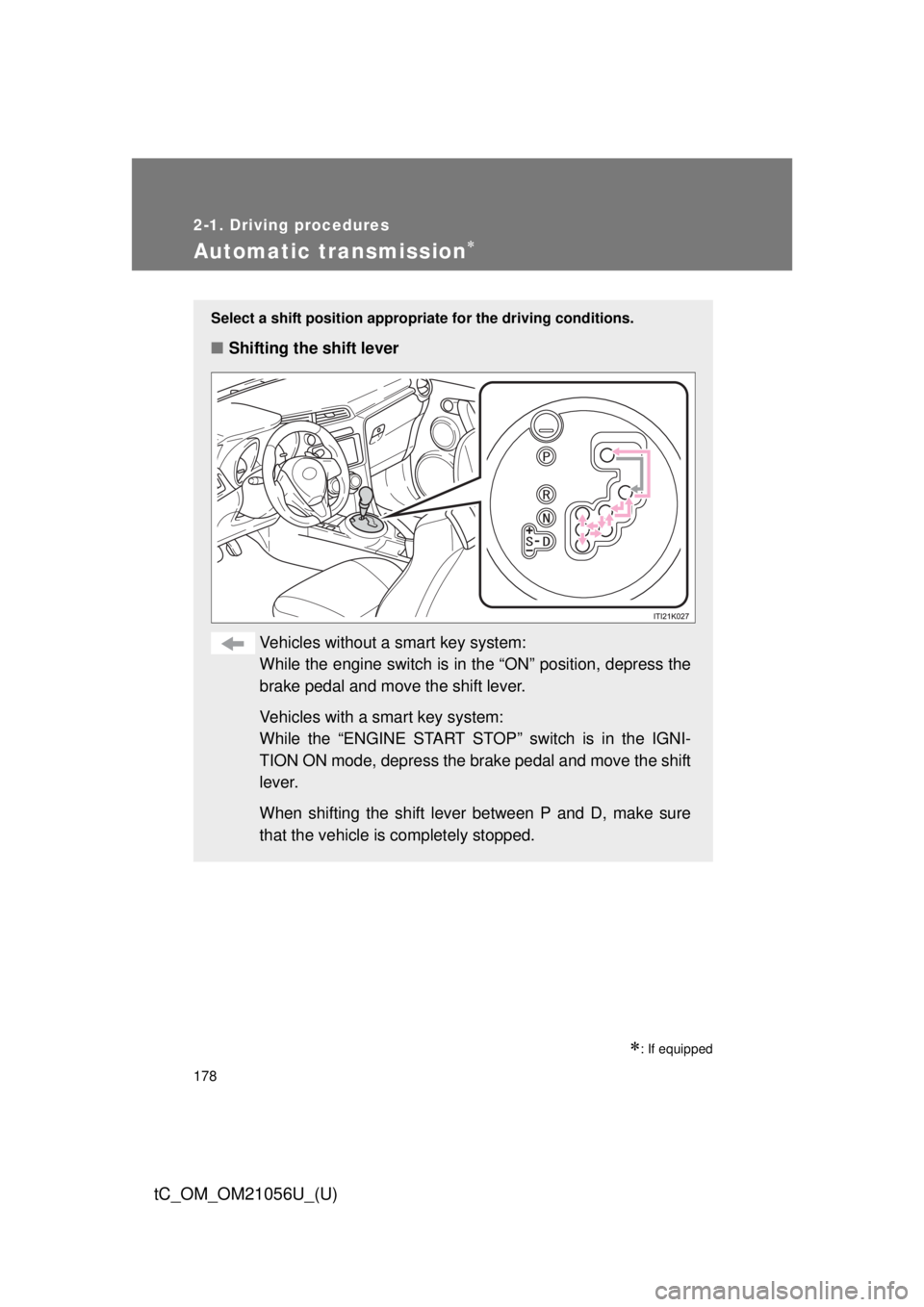
178
2-1. Driving procedures
tC_OM_OM21056U_(U)
Automatic transmission
: If equipped
Select a shift position appropriate for the driving conditions.
■Shifting the shift lever
Vehicles without a smart key system:
While the engine switch is in the “ON” position, depress the
brake pedal and move the shift lever.
Vehicles with a smart key system:
While the “ENGINE START STOP ” switch is in the IGNI-
TION ON mode, depress the brake pedal and move the shift
lever.
When shifting the shift lever between P and D, make sure
that the vehicle is completely stopped.
Page 179 of 492
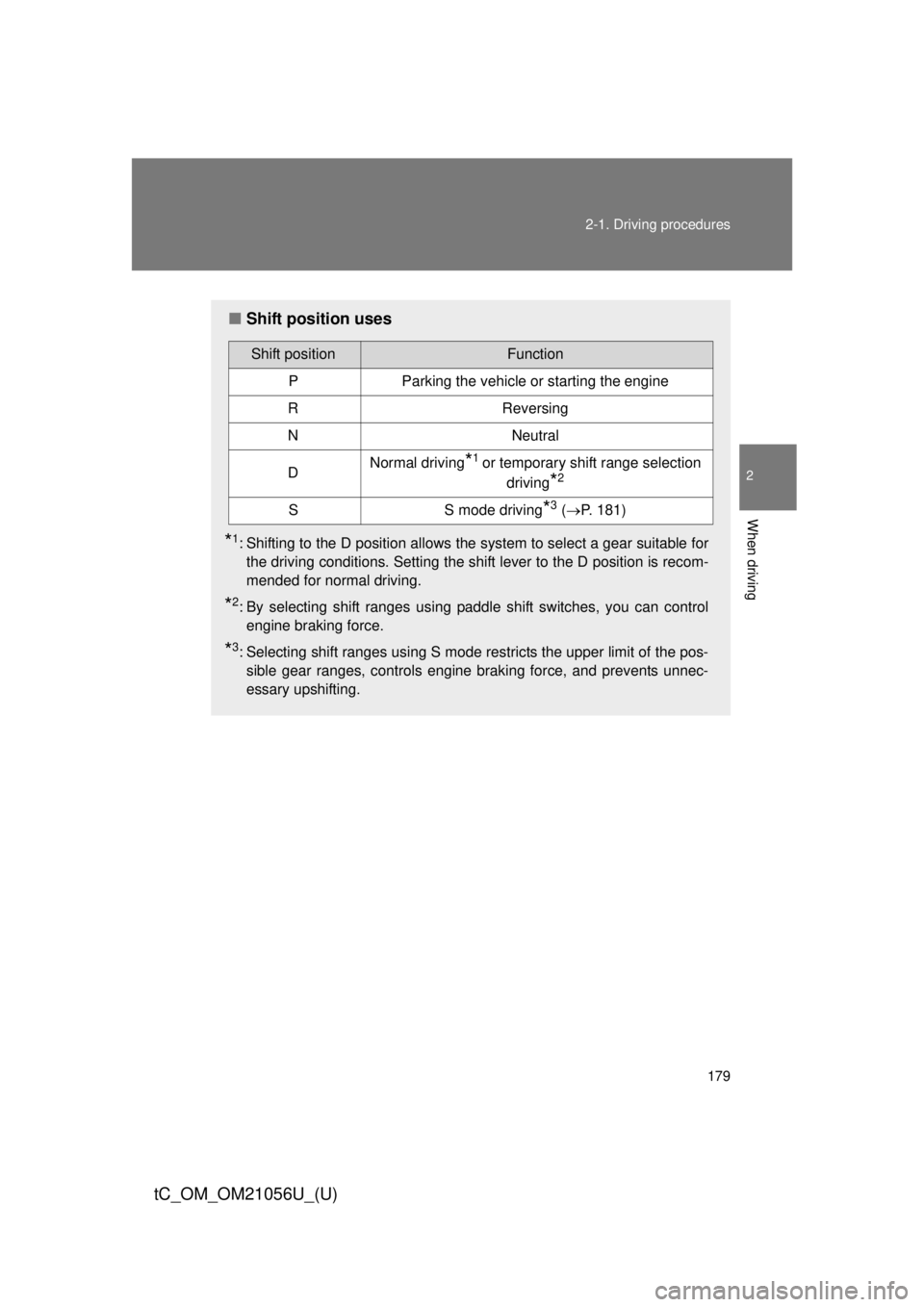
179
2-1. Driving procedures
2
When driving
tC_OM_OM21056U_(U)
■
Shift position uses
*1: Shifting to the D position allows the system to select a gear suitable for
the driving conditions. Setting the shift lever to the D position is recom-
mended for normal driving.
*2: By selecting shift ranges using paddle shift switches, you can controlengine braking force.
*3: Selecting shift ranges using S mode restricts the upper limit of the pos-sible gear ranges, controls engine braking force, and prevents unnec-
essary upshifting.
Shift positionFunction
PParking the vehicle or starting the engine
RReversing
NNeutral
DNormal driving*1 or temporary shift range selection
driving
*2
SS mode driving*3 (P. 181)
Page 180 of 492
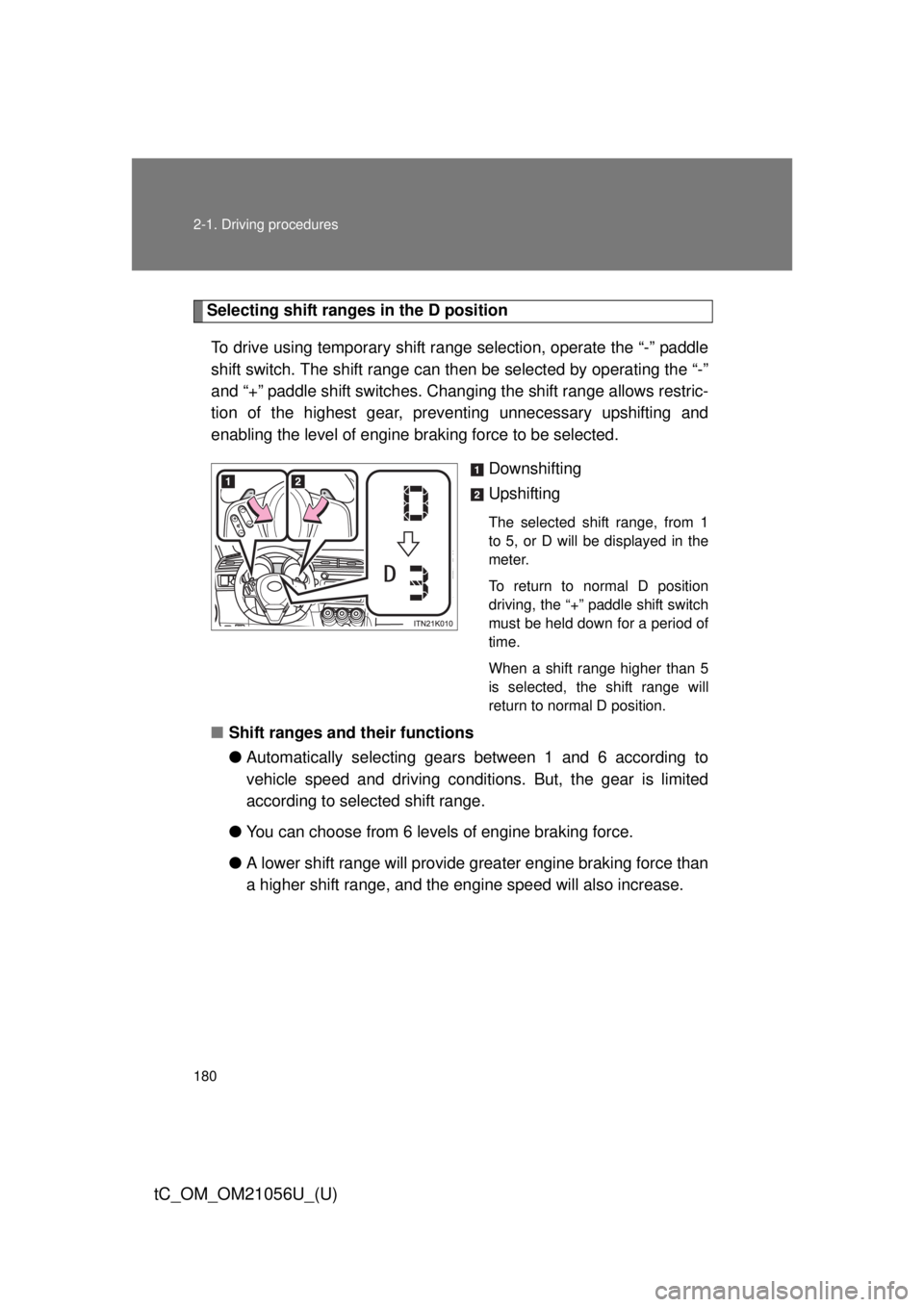
180 2-1. Driving procedures
tC_OM_OM21056U_(U)
Selecting shift ranges in the D positionTo drive using temporary shift ra nge selection, operate the “-” paddle
shift switch. The shift range can then be selected by operating the “-”
and “+” paddle shift switches. Changing the shift range allows restric-
tion of the highest gear, preventing unnecessary upshifting and
enabling the level of engine braking force to be selected.
Downshifting
Upshifting
The selected shift range, from 1
to 5, or D will be displayed in the
meter.
To return to normal D position
driving, the “+” paddle shift switch
must be held down for a period of
time.
When a shift range higher than 5
is selected, the shift range will
return to normal D position.
■Shift ranges and their functions
●Automatically selecting gears between 1 and 6 according to
vehicle speed and driving conditi ons. But, the gear is limited
according to selected shift range.
● You can choose from 6 levels of engine braking force.
● A lower shift range will provide greater engine br aking force than
a higher shift ran ge, and the engine speed will also increase.
Page 182 of 492

182 2-1. Driving procedures
tC_OM_OM21056U_(U)
■Shift ranges and their functions
●Automatically selecting gears between 1 and 6 according to
vehicle speed and driving conditi ons. But, the gear is limited
according to selected shift range.
● You can choose from 6 levels of engine braking force.
● A lower shift range will provide greater engine br aking force than
a higher shift ran ge, and the engine speed will also increase.
■Paddle shift switch
● When the “-” paddle shift switch is operated in the D position, a shift
range will be automatically selected. The highest gear of the first shift
range will be one gear lower than the gear in use during normal D posi-
tion driving.
● Automatic deactivation of shift range selection in the D position
Shift range selection in the D position will be deactivated in the following
situations:
• The “+” paddle shift switch is held down for a period of time
• When the vehicle comes to a stop
• If the accelerator pedal is depressed for longer than a certain period of
time in one shift range
■ S mode
● When the shift range is 4 or lower, holding the shift lever toward “+” sets
the shift range to 6.
● To prevent excessive engine speed, a function was adopted that auto-
matically selects a higher shift range before the engine speed becomes
too high.
● To protect the automatic transmission, a function is adopted that auto-
matically selects a higher shift range when the fluid temperature is high.
Page 183 of 492

183
2-1. Driving procedures
2
When driving
tC_OM_OM21056U_(U)
■
When driving with cruise control activated
Even when performing the following actions with the intent of enabling
engine braking, engine braking will not activate because cruise control will
not be canceled.
● While driving in S mode, downshifting to 5 or 4. ( P. 181)
● While driving in the D position, downshifting to 5 or 4. ( P. 180)
■ AI-SHIFT
AI-SHIFT automatically selects the suitable gear according to driver perfor-
mance and driving conditions.
AI-SHIFT automatically operates when the shift lever is in the D position.
(Shifting the shift lever to the S position cancels the function.)
■ If the “S” indicator does not come on even after shifting the shift lever
to S position
This may indicate a malfunction in the automatic transmission system. Have
the vehicle inspected by your Scion dealer immediately.
(In this situation, the transmission will operate in the same manner as when
the shift lever is in the D position.)
■ Downshifting restrictions warning buzzer
To help ensure safety and driving performance, downshifting operation may
sometimes be restricted. In some circumstances, downshifting may not be
possible even when the shift lever or a paddle shift switch is operated. (The
warning buzzer will sound twice.)
■ If the shift lever cannot be shifted from P
P. 4 1 1